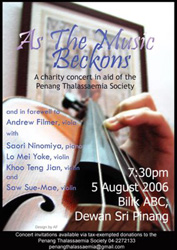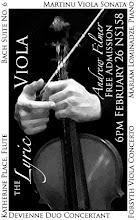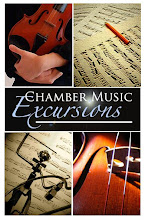Tuesday, May 03, 2005
More Medieval Meandering Marsupial’s Meaningful Musical Moments
1. This crazy Banana Phone link.
2. Beethoven: 7th Symphony, slow movement. Sadly butchered for paint ads.
3. Andrew Lloyd Webber: Final section, Love’s Maze from By Jeeves (apparently, his only commercial failure, including Joseph and His Metrosexual Versace Overcoat - well, that's what it should've been named, anyway)
4. Savage Garden: The Animal Song
5. Green Day: Time of Your Life
6. Ray Stevens: When You Get A Haircut. It's the timing; where's my lawnmower?
7. Brahms: Piano Concerto No. 1
8. Dvorak: Slavonic Dances 1 and 8 (first set)
9. Brahms: String Sextet No 2
10. Elfman: What’s This? from The Nightmare Before Christmas
11. Siti Norhaliza: Cindai
12. Rodrigo: Concierto Serenata for Harp and Orchestra
13. Bruch: Kol Nidrei for Cello and Orchestra
14. This absolutely hilarious Numa Numa video clip I petik/pinjam/curi from Seong Hong’s blog
15. Elmo’s Song from Sesame Street. Surprisingly calming. And charming.
OK, disclaimer: this next part is a classical music posting. That being done, meaningful = full of meaning, and I’ve chosen these particular recordings because I think that the combination of orchestra, conductor and soloist(s) brought out a lot of the intentions of the score. These are recordings where I can find new nuances and communication years later. With stringent faith in the laws of supply & demand, solid confidence in factoring in the angle which Alan Greenspan's hairdo seems to be tilting, and considering the smaller readership of this section, I follow economic good sense: sell the same product, but make it smaller. They are listed in no particular order of preference.
1. W.A. Mozart: Sinfonia Concertante for Violin, Viola and Orchestra, Augustin Dumay, violin solo and leader; Veronika Hagen, viola solo; The Salzburg Academic Camareta. DG.
OK, I lied, so sue me: this is my all-time favorite recording. It brings out beautiful solo lines without sacrificing the diverse orchestral texture, making a concerto into chamber music. It wins the gold medal for the pizzicatos, the connection of strings and winds, and most of all for bar 313 of the first movement – the only one of the ten recordings I’ve collected which gives due prominence to the 1st violas, so often hidden in the middle range, smothered by the violins, and only half the usual section size. The small details do count. And the rest of the list are really in no particular order. I mean, would I lie to you?
2. J. Sibelius: Violin Concerto. Nigel Kennedy, soloist; City of Birmingham Symphony Orchestra, Simon Rattle conducting. EMI.
This is Kennedy in serious mode, don’t let the leather jacket and Arsenal scarf fool you. I’ll get a CD of this eventually; it was one of the earlier recordings I collected on cassette tape. That which I can remember is that the orchestral and solo lines in the third movement, and the intention of the rhythmical motif set in place by the cellos, timpani, and solo entry remained solidly clear, and over all that, a sense of urgency.
3. M. Bruch: Violin Concerto No 1. Cho-Liang Lin, The Chicago Symphony Orchestra, Leonard Slatkin conducting. Sony.
This is a recording that I’ve been keen on for ages, and only recently been able to obtain. I think the overall sense of the big picture was obtained, especially leading up the big orchestra tutti in the introductory first movement (with a brilliant MM 121 to MM 139 accelerando). Also noted is the wide expanse of the second, and in the third movement, the clarity of lyrical lines expanding in the score – arpeggios up in one line, and descending in another.
4. F. Mendelssohn: Violin Concerto in E minor. Viktoria Mullova, soloist; The Academy of St Martin-in-the-Fields, Sir Neville Marriner conducting. Philips.
There’s something magical about the smooth gliding way the violin solo enters in the first movement, and Mullova captures this not only as a moment, but keeps it as stamp of things to come, along with a matching texture from the orchestra. I’m not a fan of single-speed vibrato, but Mullova’s bow use and tone color is quite the something.
5. J. Brahms: String Sextet No. 2. Members of the Amadeus and Alban Berg Quartets. EMI.
This ensemble only recorded the two Brahms sextets – brought together because of the death of the violist of the Amadeus Quartet, and after which the quartet retired. The massiveness of tone the music of Brahms demands is clear here, without the muddiness that bigger string ensembles are often trapped in. Unlike any other, I actually have to restrict my listening to this recording because the inclination to follow everything there is powerful – and when you work with other players, having too much of a set idea is dangerous. A great recording, and a live one too.
Subscribe to:
Post Comments (Atom)






No comments:
Post a Comment